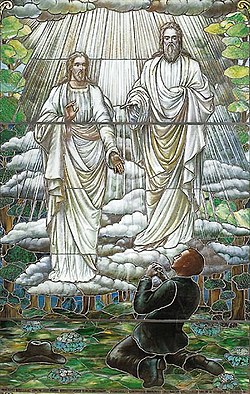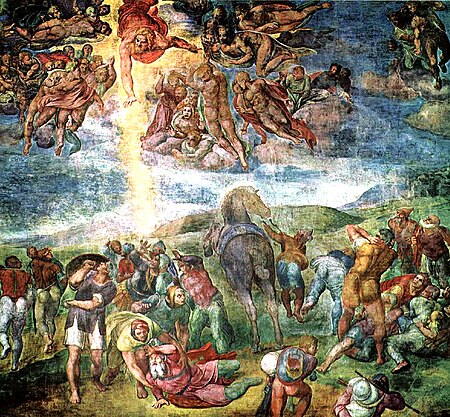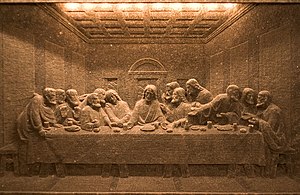
Summary
The following selected pictures appear on Portal:Christianity. The layout for new additions is at Portal:Christianity/Selected picture/Layout.
- Current number of selected pictures: 11. (Update this number if you add more random pictures.)
Portal:Christianity/Selected picture/1

In The Church of Jesus Christ of Latter-day Saints (LDS Church), a temple is a building dedicated to be a House of the Lord, and they are considered by church members to be the most sacred structures on earth. Upon completion, temples are usually open to the public for a short period of time (an "Open House"). During the Open House, the church conducts tours of the temple with missionaries and members from the local area serving as tour guides, and all rooms of the temple are open to the public. Mormon temples are used for their baptism for the dead, washing and anointing (or "initiatory" ordinances), the endowment, and Mormon marriages. The temple is then dedicated as a "House of the Lord", after which only members who are deemed worthy are permitted entrance (tithing is paid in full). Thus, they are not churches (meetinghouses) but rather places to do Mormon practices. The church is a prolific builder of temples as they hold a key place in LDS theology.
Portal:Christianity/Selected picture/2

The First Vision (also called the grove experience) refers to a vision that Joseph Smith said he received in the spring of 1820, in a wooded area in Manchester, New York, which his followers call the Sacred Grove.
Portal:Christianity/Selected picture/3

The Life of Christ as a narrative cycle in Christian art comprises a number of different subjects, which were often grouped in series or cycles of works in a variety of media, narrating the life of Jesus on earth, as distinguished from the many other subjects in art showing the eternal life of Christ, such as Christ in Majesty, and also many types of portrait or devotional subjects without a narrative element.
Portal:Christianity/Selected picture/4

The Pauline epistles, Epistles of Paul, or Letters of Paul, are the thirteen New Testament books which have the name Paul (Παῦλος) as the first word, hence claiming authorship by Paul the Apostle. Among these letters are some of the earliest extant Christian documents. They provide an insight into the beliefs and controversies of early Christianity and as part of the canon of the New Testament they are foundational texts for both Christian theology and ethics.
Portal:Christianity/Selected picture/5

The Last Judgment, Final Judgment, Day of Judgment, Judgment Day, or The Day of the Lord or in Islam Yawm al-Qiyāmah or Yawm ad-Din is part of the eschatological world view of the Abrahamic religions and in the Frashokereti of Zoroastrianism.
Portal:Christianity/Selected picture/6

The Siege of Belgrade (1456) or Battle of Belgrade or Siege of Nándorfehérvár occurred from July 4–22, 1456. After the fall of Constantinople in 1453, the Ottoman Sultan Mehmed II rallied his resources in order to subjugate the Kingdom of Hungary. His immediate objective was the border fort of the town of Belgrade (in old Hungarian Nándorfehérvár). John Hunyadi, the Voivode of Transylvania, who had fought many battles against the Turks in the previous two decades, prepared the defenses of the fortress. Since 22 July 2011, the date when Christian forces led by John Hunyadi and John of Capistrano defeated the Ottoman Turks besieging Belgrade in 1456, has been a national memorial day in Hungary.
Portal:Christianity/Selected picture/7

Christ the King is a title of Jesus based on several passages of Scripture. It is used by most Christians.
Portal:Christianity/Selected picture/8

The Finding in the Temple, also called "Christ among the Doctors" or the Disputation (the usual names in art), was an episode in the early life of Jesus depicted in the Gospel of Luke. It is the only event of the later childhood of Jesus mentioned in a gospel.
Portal:Christianity/Selected picture/9

Conversion to Christianity is the religious conversion of a previously non-Christian person to some form of Christianity. It has been called the foundational experience of Christian life. Conversion to Christianity primarily involves belief (faith) in the Christian God, thinking that they are far short of the Christian God's apparent "glory and holiness" (sin), repentance of "sin", and confession of their belief that Jesus Christ is the Son of God and the all-sufficient and only means by whom one's sin can be atoned for and therefore the only route to salvation.
Portal:Christianity/Selected picture/10

A Christian martyr is a person who is killed for following Christianity, through stoning, crucifixion, burning at the stake or other forms of torture and capital punishment. The word "martyr" comes from the Greek word μάρτυς, mártys, which means "witness." At first, the term applied to Apostles. Once Christians started to undergo persecution, the term came to be applied to those who suffered hardships for their faith. Finally, it was restricted to those who had been killed for their faith. The early Christian period before Constantine I was the "Age of martyrs". A martyr's death was considered a "baptism in blood," cleansing one of sin, similar to the effect of baptism in water. Early Christians venerated martyrs as powerful intercessors, and their utterances were treasured as inspired by the Holy Spirit.
Portal:Christianity/Selected picture/11

A rendering of the Last Supper made from salt, Wieliczka salt mine, Poland
This is an archive of selected pictures that have appeared or will appear on Portal:Christianity in the current year. To suggest an item, please do so here.


